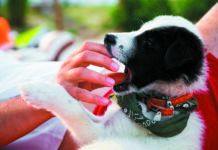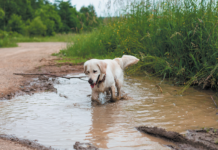What to feed the dog in Italy
Q: My dog—a 13-pound terrier mix—loves a particular brand of food, and that’s what I feed her. But this month, I will be traveling with her to Italy for two weeks, and, of course, I cannot feed her the preferred brand for that period.
I’m wondering if freeze-dried food would be a suitable substitute, or if that would be too drastic a change. What might you recommend? Thank you for your consideration.
Gordon Shumaker
Woodbury Minnesota
Fear of tripping over the dog
Q: I appreciated your article last month about not falling while walking your dog. I actually have a problem much closer to home—in my home, in fact. Often (pretty much daily) when I’m walking through the house, my dog (a 10-year-old Maltipoo) cuts right in front of me. Setting aside the issue that he needs to be trained not to do this, do dogs not have a sense of space and their place in it? Could it be that their peripheral vision is lacking? Or might there be some other biological cause? I never move without looking down out of fear of tripping over him.
4 Easy Tips for Making Your Dog’s Walks More Enjoyable
Imagine if each day you went to open up your favorite websites for news or new ideas, and the same articles kept popping up over and over, except for a couple of short bits off to the side. That’s how it is for a dog who is taken on the same route, or the same couple of routes, for all her walks. When a dog goes outside, she’s not just relieving herself. She’s reading her world—by sight and hearing but mostly through scent. If she pretty much has to keep “reading” the same thing over and over, life can feel awfully tedious. Here’s how to make your dog’s walks more enlivening.
Help Your Dog Live a Longer, Healthier Life
Many dog owners aren’t sure how to determine their dog’s body condition. Even more confusing, a recent Pet Obesity U.S. Prevalence Survey found that more than a third of people with dogs consider their body condition “normal” when their veterinarians actually classified the pets as overweight or obese. So where might this disconnect come from?
Post Pup-tum Depression?
We’ve all heard of the baby blues—that short-term drop in mood coupled with melancholy soon after a baby’s birth. It turns out that “parents” of new puppies can experience the “baby” blues, too.
When Training Dramatics Backfire—and When They Work
Your dog runs over to someone who doesn’t like dogs or worse, jumps on the person. Or he starts bothering another dog. Your instinct might be to yell at your pet to stop and make a lot of fuss with gesticulations. But all of that fanfare is counterproductive; the commotion only begets more commotion.
Hack for Reducing Dog Odors
Dog hair and the dander it traps carry odors, so especially if you have a particularly furry or long-haired dog, it’s a good idea to vacuum every two to three days—not just rugs but also upholstered furniture and drapes.
Dog-Walking Injuries on the Rise
Dog-walking injuries caused by dogs pulling on the leash increased by roughly 300 to 400 percent between 2001 and 2020, according to researchers reporting in the Journal of the American Veterinary Medical Association. Women are “overrepresented” in the statistics, the researchers say, particularly if they are at least 65. The investigators made their findings when they evaluated a number of studies on emergency room visits.
On Whether to Give a Poor Dog a Bone
Which bones are safer than you might think; which are dangerous for your pet.
Bridging the Communication Gap
If only we could translate our dogs’ communications with more precision so we could better tend to their physical and emotional needs. It’s coming.
You Want to Rent the Apartment, But the Lease Says ‘No Pets Allowed’
You’ve found a wonderful place to live, and though the lease says “No pets allowed,” you’ve been back to the apartment building a few times and have seen another renter walking their dog on the grounds. You’ve even seen a dog in a window, so you figure it won’t be a problem—kind of like the dog owner’s equivalent of jaywalking. But it very well could.
For How Long Can a Dog Food Be “New” and “Improved”?
Have you ever seen the words “new” or “improved” on a dog food label? If so, it shouldn’t be there for more than the first six months of production. “It’s not new forever,” says the Association of American Feed Control Officials (AAFCO), whose guidelines are generally written into law by each state legislature.















